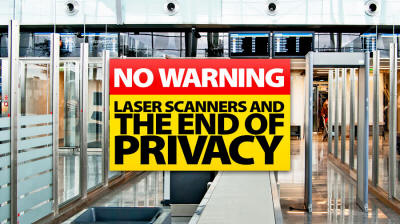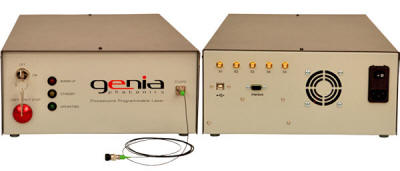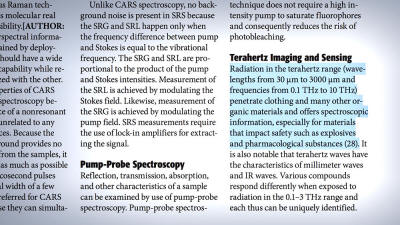
by Washington's Blog
July 12, 2012
from
GlobalResearch Website
Government Will Soon Be Able to Know
Your Adrenaline Level,
What You Ate for Breakfast and What
You’re Thinking… from 164 Feet Away
Do You Know How Far
Government Spying Has Gone?
You might have heard that police are deploying scanners - not only in
airports - but
also on trains, buses, ferries, sporting events and on the
streets. And see
this.
You probably know that the National Security Agency (NSA)
is
building a $2 billion dollar facility in Utah which will use the
world’s most powerful supercomputer to
monitor virtually all phone calls,
emails, internet usage, purchases and rentals, break all encryption, and
then store everyone’s data permanently.
And that
the CIA is trying to
tap your communications as well. You may
have heard that drones will soon be flown all over America to spy on us.
For example, ABC News
reported:
Drones can carry facial recognition cameras,
license plate scanners, thermal imaging cameras, open WiFi sniffers, and
other sensors. And they can be armed.
Without privacy and transparency rules - these powerful surveillance
tools… have strong potential for misuse.
The military is already using drones over the
American homeland to gather information on Americans. See
this and
this.
AP notes that the American public is
wary of drones:
Public worries about drones began mostly on
the political margins, but there are signs that they’re going
mainstream.
An ACLU lobbyist, Chris Calabrese, said that when he speaks to audiences
about privacy issues, drones are what “everybody just perks up over.”
For unbelievable video showing the
maneuverability of the new generation of drones, watch
this,
this and
this.
And remember that drones can be as small as
golf balls,
birds... or even
insects (and see
this).
That’s nothing...
Gizmodo reports today "Hidden
Government Scanners Will Instantly Know Everything About You from 164 Feet
Away"...
Note: Researchers at
Cornel university are working on ways to scan which are even cheaper…
leading to the possibility that these type of scanners could one day be
ubiquitous.
I Heard That…
Moreover, as Newsweek, Telegraph, the Daily Record, IEEE and many other
mainstream sources have reported on experiments showing that mind-reading
machines have gone from the realm of science fiction to engineering fact.
Newsweek points out:
Nothing in physics rules out remote
detection of brain activity.
In fact, says law professor Hank Greely of
Stanford, an infrared device under development might read thoughts using
little more than a headband. He can imagine a despot scanning citizens’
brains while they look at photos of him, to see who’s an opponent.
As with all technology, some uses will bring unalloyed benefits
(translating a quadriplegic’s thoughts to move a prosthetic limb). Other
uses... well, as Greely says, “we really don’t know where this will
end.”
That mind reading has begun, however, there
is now no doubt.
Indeed, patents were granted for machines which
can read people’s thoughts at a distance 35 years ago, and IBM predicts that
mind-reading machines will be everywhere in 5 years.
We posted numerous videos in December showing mind-reading machines in
action.
There are now prototypes of machines which can
read your mind for a wide variety of purposes (they include driving,
computers, music, and other uses with higher potentials for abuse):
For Good or For Ill?
Technology can be used to make us healthier, more prosperous and more
interconnected... or it can be used to impose tyranny.
In a time age when yawning, having goose bumps, liking liberty and doing
just about anything that average, normal people do can get you labelled as a
potential terrorist, the risk of the technology being used for repressive
purposes has to be taken seriously.
Indeed, the government has been spying on many - or most - Americans for
years. Indeed, massive spying started before 9/11.
The government monitoring efforts will not focus on spying on potential
terrorists - or even criminal activity - but in recording every phone call,
email, internet search or other communication in the country.
Indeed, the spying isn’t being done to keep us safe... but to crush
dissent... and to help the too big to fail businesses compete against
smaller businesses (and here).
As influential senator Frank Church warned in 1975:
“Th[e National Security Agency's] capability
at any time could be turned around on the American people, and no
American would have any privacy left, such is the capability to monitor
everything: telephone conversations, telegrams, it doesn’t matter.
There
would be no place to hide. [If a dictator ever took over, the N.S.A.]
could enable it to impose total tyranny, and there would be no way to
fight back.“
The former head of the above-described NSA
spying program held his thumb and forefinger close together, and said:
We are, like, that far from a turnkey
totalitarian state.
On the other hand, the ability to fly our own
drones for $300 (and remember, the parts for this one are just over $1,000)
may mean that technology will be available for the people to keep an eye on
our government, just as the web has helped empowered us to “be the media”
and to hold our leaders to account.
Whether technology imprisons us or frees us remains to be seen.
And the result is largely up to us: scientists,
engineers and we the people as a whole.
Hidden Government Scanners
...Will Instantly Know Everything About You from 164 Feet
Away
July 10, 2012
from
Gizmodo Website
|
The author of this story is
currently completing his PhD in renewable energy solutions, focusing
on converting waste to energy in the urban environment. Even while
most of this information is publicly available, he wanted to remain
anonymous. |

Within the next year or two, the U.S. Department of Homeland Security will
instantly know everything about your body, clothes, and luggage with a new
laser-based molecular scanner fired from 164 feet (50 meters) away.
From traces of drugs or gun powder on your
clothes to what you had for breakfast to the adrenaline level in your body -
agents will be able to get any information they want without even touching
you.
And without you knowing it.
The technology is so incredibly effective that, in November 2011, its
inventors were
subcontracted by In-Q-Tel to work with the US Department of
Homeland Security.
In-Q-Tel is a company founded,
"in February 1999 by a group of private
citizens at the request of the Director of
the CIA and with the support
of the U.S. Congress."
According to In-Q-Tel, they are the bridge
between the Agency and new technology companies.
Their plan is to install this molecular-level scanning in airports and
border crossings all across the United States. The official, stated goal of
this arrangement is to be able to quickly identify explosives, dangerous
chemicals, or bioweapons at a distance.
The machine is ten million times faster - and one million times more
sensitive - than any currently available system. That means that it can be
used systematically on everyone passing through airport security, not just
suspect or randomly sampled people.
Analyzing everything
in real time
But the machine can sniff out a lot more than just explosives, chemicals and
bioweapons.
The company that invented it,
Genia Photonics,
says that its laser scanner technology
is able to,
"penetrate clothing and many other organic
materials and offers spectroscopic information, especially for materials
that impact safety such as explosives and pharmacological substances."
Formed in Montreal in 2009 by PhDs with
specialties in lasers and fiber optics, Genia Photonics has 30 patents on
this technology, claiming incredible biomedical and industrial applications
- from identifying individual cancer cells in a real-time scan of a patient,
to detecting trace amounts of harmful chemicals in sensitive manufacturing
processes.

The Genia Photonics'
Picosecond Programmable Laser scanner
is capable of detecting every
tiny trace of any substance on your body,
from specks of gunpowder to
your adrenaline levels
to a sugar-sized grain
of cannabis to what you had for breakfast.
Meanwhile, In-Q-Tel
states that,
"an important benefit of Genia Photonics'
implementation as compared to existing solutions is that the entire
synchronized laser system is comprised in a single, robust and
alignment-free unit that may be easily transported for use in many
environments…
This compact and robust laser has the
ability to rapidly sweep wavelengths in any pattern and sequence."
So not only can they scan everyone. They would
be able to do it everywhere: the subway, a traffic light, sports events...
everywhere.
How does it work?
The machine is a mobile, rack-mountable system.
It fires a laser to provide
molecular-level feedback at distances of up to 50 meters in just
picoseconds. For all intents and purposes, that means instantly.
The small, inconspicuous machine is attached to a computer running a program
that will show the information in real time, from trace amounts of cocaine
on your dollar bills to gunpowder residue on your shoes. Forget trying to
sneak a bottle of water past security - they will be able to tell what you
had for breakfast in an instant while you're walking down the hallway.
The technology is not new, it's just millions times faster and more
convenient than ever before.
Back in 2008, a
team at George Washington
University developed a similar laser spectrometer using a different process.
It could sense drug metabolites in urine in less than a second, trace
amounts of explosive residue on a dollar bill, and even certain chemical
changes happening in a plant leaf.
And the
Russians also have a similar technology: announced last April, their
"laser sensor can pick up on a single
molecule in a million from up to 50 meters away."
So if Genia Photonics' claims pan out, this will
be an incredible leap forward in terms of speed, portability, and
convenience. One with staggering implications.
Observation without limits
There has so far been no discussion about the personal rights and privacy
issues involved.
Which "molecular tags" will they be scanning
for? Who determines them? What are the threshold levels of this scanning? If
you unknowingly stepped on the butt of someone's joint and are carrying a
sugar-sized grain of cannabis like that
unfortunate traveler currently in
jail in Dubai, will you be arrested?
And, since it's extremely portable,
-
Will this technology extend beyond the
airport or border crossings and into police cars, with officers looking for
people on the street with increased levels of adrenaline in their system to
detain in order to prevent potential violent outbursts?
-
And will your car be
scanned at stoplights for any trace amounts of suspicious substances?
-
Would all this information be recorded anywhere?

A page from a Genia
Photonics paper
describing its ability to even penetrate through clothing.
There are a lot of questions with no answer yet,
but it's obvious that the potential level of personal invasion of this
technology goes far beyond that of body scans, wiretaps, and GPS tracking.
The end of privacy
coming soon
According to the undersecretary for science and technology of the Department
of Homeland Security, this scanning technology
will be ready within one to
two years, which means you might start seeing them in airports as soon as
2013.
In other words, these portable, incredibly precise molecular-level scanning
devices will be cascading lasers across your body as you walk from the
bathroom to the soda machine at the airport and instantly reporting and
storing a detailed breakdown of your person, in search of certain "molecular
tags".
Going well beyond eavesdropping, it seems quite possible that U.S.
government plans on recording molecular data on travelers without their
consent, or even knowledge that it's possible - a scary thought.
While the medical uses could revolutionize the
way doctors diagnose illness, and any technology that could replace an
aggressive pat-down is tempting, there's a potential dark side to this
implementation, and we need to shine some light on it before it's
implemented.



